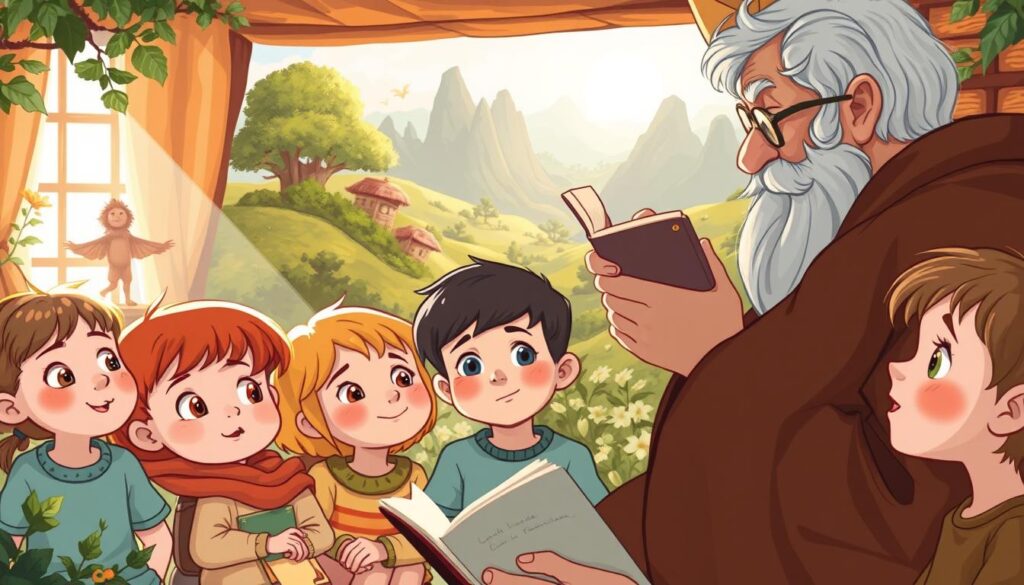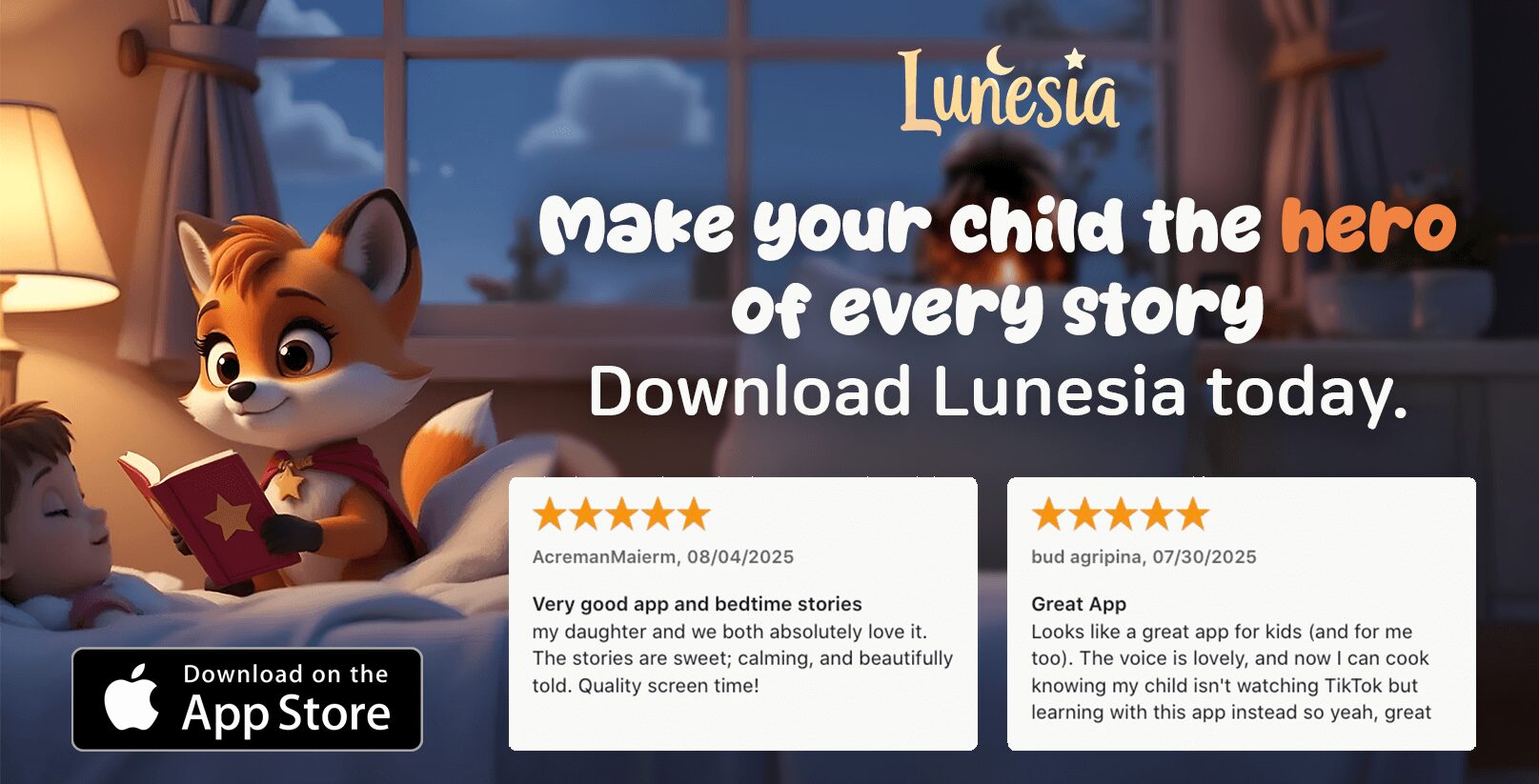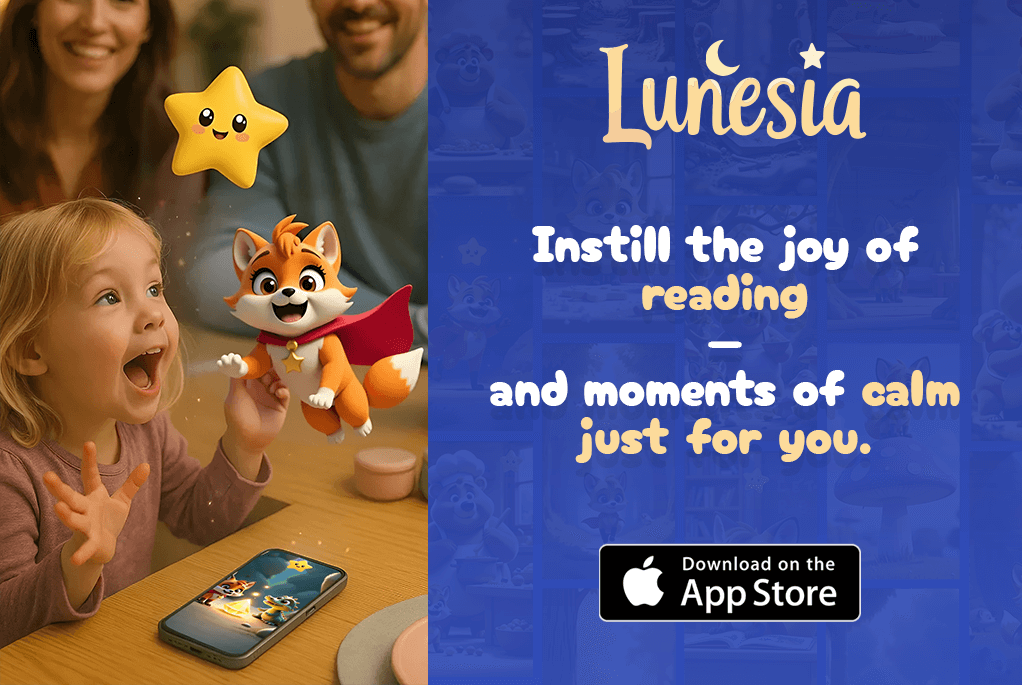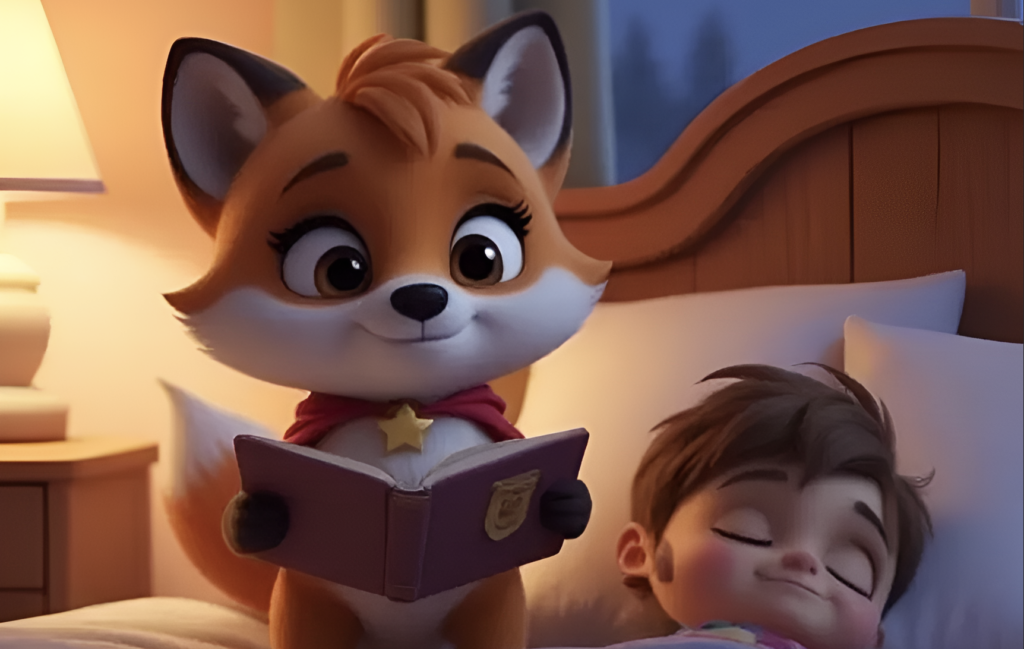What if the simplest stories hold the keys to raising kind, thoughtful children? I’ve often marveled at how tiny tales—like The Tortoise and the Hare or The Lion and the Mouse—stick with us long after childhood. These narratives aren’t just entertainment. They’re quiet teachers, shaping young minds through relatable characters and timeless wisdom.
Think about it: A hungry fox learns not to crave sour grapes. A slow tortoise proves persistence beats speed. These stories work because they speak to children without preaching. Instead, they invite curiosity. “What would you do?” becomes a doorway to discussions about honesty, courage, and fairness.
As a parent, I’ve watched my own child grasp complex ideas through these bite-sized lessons. One evening, after reading about the ant who prepared for winter, my son asked, “Should I finish my homework now instead of waiting?” That’s the magic. These tales become part of their worldview—gentle guides they carry into adulthood.
For generations, families have shared collections like Aesop’s fables, passing down values through playful storytelling. Today, that tradition continues. Whether it’s a worn book or a bedtime retelling, these narratives remain powerful tools. Ready to discover how small stories create big impacts? Let’s explore the wisdom hiding in plain sight.
Introduction: The Magic Behind Fables and Their Impact on Children
There’s a quiet power in tales whispered across generations. I remember watching my niece pause mid-storytime to ask, “Why didn’t the fox just ask for help?” That moment—when a simple narrative sparks deeper thinking—is where the real magic lives. These stories aren’t just bedtime routines; they’re stepping stones for developing empathy and decision-making skills.
What gives these age-old lessons their staying power? They meet children where they are. A talking turtle becomes a mentor on patience. A stubborn goat on a bridge models conflict resolution. By wrapping truths in playful imagery, complex ideas feel approachable. “Let’s see what happens next…” becomes code for exploring life’s gray areas together.
I’ve seen how these tales grow with kids. A story about sharing berries at age four evolves into discussions about fairness by seven. Last month, a parent told me how her son referenced “The Two Goats” during a playground disagreement—proof these narratives stick long after the book closes.
In our fast-paced world, fables offer something rare: space to reflect. They don’t demand instant answers but invite curiosity. When a child wonders why the sun outsmarted the wind, they’re not just hearing a plot—they’re learning persuasion beats force. And isn’t that the kind of wisdom we all want our kids to carry?
The Historical Roots of Fables in Ancient Greece
Long before bedtime stories became a ritual, ancient Greeks gathered in marketplaces to hear tales spun from everyday life. I’ve always been fascinated by how these narratives—crafted over 2,500 years ago—still whisper wisdom to our children today. At their core, they reveal a truth: human nature changes far slower than technology.
Aesop, believed to have been an enslaved storyteller in 6th-century Greece, turned simple observations into timeless lessons. His collection used talking animals to mirror society’s triumphs and flaws. Take “The Town Mouse and the Country Mouse”—a story about contentment that still sparks family discussions about valuing what we have.
Why did these stories endure? They weren’t just entertainment. In a time without formal schools, fables taught critical thinking. Imagine a parent pointing to a tortoise while saying, “Slow and steady wins the race.” Visual, memorable, practical.
| Ancient Fable | Historical Theme | Modern Parallel |
|---|---|---|
| The Lion & the Mouse | Power dynamics | Kindness transcends status |
| The Ants & the Grasshopper | Community responsibility | Preparing for challenges |
| The Town Mouse | Class differences | Appreciating simplicity |
Recently, a friend shared how her child reenacted “The North Wind and the Sun” with stuffed animals. “Why does kindness work better than force?” she asked. That’s the magic—these narratives invite questions that bridge centuries.
When we share Aesop’s fables, we’re not just passing down stories. We’re giving children a lens to view their world through ancient wisdom—one playful parable at a time.
Aesop Fables: Timeless Stories and Enduring Lessons
I still have my dog-eared copy of Aesop’s stories from third grade—the one with ink smudges where I traced the lion’s mane in wonder. That’s the secret: these tales grow with us. A child laughs at a talking goose, while adults nod at its deeper truth about greed. This dual magic makes Aesop’s fables collection a bridge between generations.
Why do “The Goose That Laid the Golden Eggs” and “The Lion and the Mouse” remain staples? They teach without scolding. A selfish farmer loses his golden goose. A mighty lion spares a tiny mouse—later saved by it. Cause and effect becomes visible through fur and feathers.
Modern editions like Milo Winter’s illustrated book prove these stories adapt without losing their core. Vivid artwork pulls young readers in, while layered meanings spark family discussions. One parent recently told me: “My daughter asked why the farmer didn’t just feed the goose better. We talked about patience for days!”
Three reasons these lessons endure:
- Animal characters disarm defenses—children listen without feeling judged
- Clear consequences: Honesty rewards, greed punishes
- Open-ended questions invite critical thinking (“What would you tell the farmer?”)
Centuries may pass, but human nature stays familiar. Aesop’s fables mirror our best and worst instincts—then show a wiser path. Whether through bedtime readings or classroom debates, they remain quiet mentors for every age.
The Wind and the Sun: A Gentle Lesson in Persuasion
Have you ever tried convincing a stubborn toddler to wear shoes? That’s where an ancient weather story becomes surprisingly useful. In this classic tale, the North Wind and the Sun argue over who’s stronger. Their challenge? Removing a traveler’s cloak. What unfolds teaches more about human nature than any parenting manual.
![]()
Story Background and Context
First recorded in Aesop’s collection, this story pits two forces against each other. The Wind huffs and puffs, trying to rip off the cloak through sheer force. But the traveler only grips tighter. Then the Sun shines warmly—gradually, the traveler removes the cloak willingly. “Kindness disarms resistance,” a parent once told me after using this story during sibling arguments.
| Approach | Method | Outcome | Modern Application |
|---|---|---|---|
| Wind’s Strategy | Forceful demands | Increased resistance | Power struggles over homework |
| Sun’s Strategy | Calm encouragement | Cooperation | Negotiating screen time limits |
Moral Insights for Today’s Children
This moral isn’t just about weather patterns. It’s a blueprint for resolving conflicts without tears. Last week, a mom shared how her daughter referenced the story when asked to clean up: “Can we be like the Sun? I’ll do it faster if you smile!”
Three ways this story translates to 21st-century parenting:
- Models emotional regulation during disagreements
- Shows patience as strength, not weakness
- Encourages creative problem-solving over demands
Centuries-old wisdom meets playground diplomacy. Whether calming tantrums or navigating friendships, this time-tested lesson reminds us: warmth often works where force fails.
The Boy Who Cried Wolf: A Cautionary Tale on Honesty
Last Tuesday, my neighbor’s son lied about finishing his vegetables—then burst into giggles. That playful mischief reminded me why Aesop’s “The Boy Who Cried Wolf” remains so vital. This ancient story about a shepherd’s false alarms teaches what no lecture can: trust, once broken, takes time to rebuild.
Story Summary and Core Message
A bored shepherd repeatedly tricks villagers with fake wolf attacks. When a real wolf appears, no one believes him. The moral? “Liars aren’t believed even when telling the truth.” Simple, yet profound. Like “The Lion and the Mouse,” consequences feel immediate through animal characters.
Modern Relevance of the Tale
In our age of viral rumors and quick clicks, this fable feels urgent. A teacher friend shared how her class discussed the story after a student faked illness: “They grasped why honesty matters more than attention.”
| Fable Element | Original Lesson | Modern Parallel |
|---|---|---|
| False Alarms | Wasting resources | Spreading online misinformation |
| Real Wolf Attack | Ignored cries | Distrust in repeated excuses |
| Shepherd’s Regret | Accountability | Repairing broken trust |
Try this during storytime: Pause before the wolf appears. Ask, “What would you do if no one believed you?” My niece once whispered, “I’d tell the truth faster next time.” That’s the power of these lessons—they let children reach conclusions themselves.
Other Beloved Fables and Their Moral Teachings
Last summer, my nephew declared sour grapes were better than none—proof these tales live in modern slang. Stories like The Fox and the Grapes or The Tortoise and the Hare seep into daily language, becoming shorthand for life’s frustrations and triumphs.
Classic Examples Like Fox Grapes and Tortoise & Hare
Consider the fox who dismisses unreachable grapes as “probably sour.” Children instantly grasp its message about handling disappointment. I’ve seen teens use “sour grapes” to describe sports losses—a testament to how these metaphors stick.
The tortoise’s victory over the speedy hare teaches more than persistence. Last month, a soccer coach shared how her team chanted “slow and steady” during penalty kicks. These narratives become shared reference points, helping families discuss complex emotions through simple analogies.
| Fable | Surface Lesson | Deeper Insight |
|---|---|---|
| Fox & Grapes | Avoiding envy | Reframing failures |
| Tortoise & Hare | Consistency matters | Humility in success |
| Town Mouse & Country Mouse | Contentment | Values over status |
What makes these tales work? Three storytelling secrets:
- Animal characters let children critique behaviors without personal shame
- Clear cause-effect relationships (“Boastful hare loses”)
- Open endings invite discussion (“Would you choose city life or country peace?”)
When my sister’s family moved, they debated using The Town Mouse and the Country Mouse to ease the transition. Their kids later drew parallels between the story and their new neighborhood—proof that fables build bridges across experiences.
These narratives also create a common language between generations. A grandmother’s “tortoise wisdom” might guide homework habits, while a teacher’s “fox moment” could address classroom jealousy. Like heirlooms, these stories gain meaning each time they’re shared.
fables for kids: Sparking Imagination and Critical Thinking
I once watched a group of children turn a simple fable into an entire puppet show—complete with paper bag wolves and sock puppet sheep. Their teacher later told me: “When we read ‘The Lion and the Mouse,’ they didn’t just listen. They became the story.” That’s the power of these narratives. They don’t just teach—they transform.
Creative retelling lets young minds explore possibilities. After hearing “The Town Mouse and Country Mouse,” my niece redesigned the ending using Lego houses. “What if they visited each other more?” she wondered. This kind of play builds problem-solving skills while making abstract ideas tangible.
| Activity | Skill Developed | Example Fable |
|---|---|---|
| Drawing alternate endings | Creative reasoning | The Fox & Grapes |
| Role-playing dialogues | Empathy building | The Two Goats |
| Group story mapping | Collaborative thinking | The Ants & Grasshopper |
Parents often share how these tales spark unexpected conversations. One dad described his son’s question after “The Tortoise and the Hare”: “Is it okay to take naps if you’re ahead?” These moments turn bedtime stories into launchpads for exploring ethics and strategy.
Interactive techniques work wonders. Try pausing mid-story to ask: “What would you say to the character here?” I’ve seen classrooms erupt with ideas—from rewriting grumpy fox dialogues to inventing kinder solutions for quarrelsome goats. It’s not just about the moral; it’s about letting young thinkers engage with timeless dilemmas.
When children draw their own fable illustrations or act out scenes, they’re not just having fun. They’re learning to see stories as living conversations—ones that stretch across generations and spark new questions with every retelling.
Incorporating Illustrated Fable Books into Learning
When my daughter first saw Milo Winter’s vibrant tortoise racing across the page, she gasped—“He looks so serious!” That moment revealed the magic of illustrated editions. Artwork transforms words into worlds, helping young readers visualize lessons about perseverance and kindness.

The Milo Winter Edition and Its Appeal
Winter’s 1919 collection remains a gold standard for good reason. His detailed animal expressions make abstract concepts tangible—a smug hare’s smirk or a mouse’s determined frown. Teachers often share how these visuals spark discussions: “Why does the lion look surprised?” becomes a gateway to exploring gratitude.
| Edition Feature | Child Engagement | Parent Tip |
|---|---|---|
| Full-page illustrations | Predicting story outcomes | Ask: “What happens next?” |
| Character close-ups | Identifying emotions | Discuss facial expressions |
| Background details | World-building curiosity | Explore settings together |
Using Coloring Books for Active Engagement
Blank tortoise shells and uncolored grapes invite participation. Last month, a librarian showed me pages where kids added patterns to the fox’s fur—“They debated whether stripes would make him wiser.” This hands-on approach deepens understanding while developing fine motor skills.
Three ways to maximize illustrated books:
- Compare different artists’ styles (How does this mouse look friendlier?)
- Use wordless pages for storytelling practice
- Frame finished coloring pages as “lesson reminders”
When choosing editions, seek balance. The best versions pair rich artwork with clear text. Our family’s worn Milo Winter copy proves—when images and words work together, timeless lessons take flight.
Using Fables to Build Cultural Literacy and Moral Vocabulary
Every culture whispers its wisdom through stories that outlive empires. When my niece compared her friend’s birthday envy to “sour grapes,” I realized these tales do more than teach—they create shared language for discussing life’s complexities. Aesop’s fables act as cultural bridges, connecting ancient insights to modern dilemmas.
Consider how common phrases like “wolf in sheep’s clothing” or “lion’s share” originate from these narratives. They become reference points in unexpected places—a teacher using “the tortoise’s lesson” during math struggles, or a coach referencing “the two goats” to resolve team conflicts.
| Fable | Cultural Concept | Modern Dialogue Starter |
|---|---|---|
| The Ant & Grasshopper | Delayed gratification | “Should we save allowance or spend now?” |
| The Fox & Grapes | Cognitive dissonance | “How do you handle disappointment?” |
| The Town Mouse | Lifestyle values | “What makes a ‘good’ life?” |
These stories also unlock historical context. When children encounter “Aesop’s fables” in literature class, they’re not just reading—they’re recognizing patterns that shaped Western thought. A parent recently shared: “My son noticed ‘the sun’s strategy’ in a Civil Rights documentary—it clicked how persuasion transcends time.”
Three ways to deepen cultural literacy through fables:
- Connect animal choices to human traits (Why lions represent power?)
- Compare versions across cultures (How does Anansi differ from Aesop?)
- Relate morals to current events (What would the shepherd say about fake news?)
By weaving these tales into daily conversations, families create living traditions. The lessons become more than bedtime stories—they’re tools for navigating schoolyard politics, family decisions, and societal challenges with ancient wisdom as their guide.
Practical Tips for Storytelling and Narrative Engagement
Ever watched a child’s eyes glaze over during storytime? I learned the hard way that reading aloud isn’t enough—it’s the shared experience that sparks connection. One evening, my nephew interrupted “The Lion and the Mouse” to ask, “But why wouldn’t the lion eat him?” That moment taught me: engagement begins when we let kids steer the tale.
Interactive Reading Techniques
Turn pages into playgrounds. A friend swears by her “prop box”—scarves for mouse tails, paper crowns for lions. During “The Fox and the Grapes,” her daughter draped a green blanket as vines. “It’s not cheating—it’s setting the scene!” she laughed. Simple tools transform passive listening into active participation.
Try these methods:
- Pause for predictions: “What’s the tortoise thinking right now?”
- Assign character voices: Let kids roar like lions or squeak like mice
- Create alternative endings: “Should the hare get a second chance?”
One parent shared how her son redesigned “The Two Goats” using LEGO bridges. “He made them take turns—totally changed the moral!” These adaptations show children their ideas shape stories.
| Technique | Skill Developed | Example |
|---|---|---|
| Question Flood | Critical Thinking | “Why did the ant refuse help?” |
| Role Swap | Empathy | “Be the wind—how would you persuade?” |
| Prop Exploration | Creativity | Using spoons as turtle shells |
Remember, a well-loved book isn’t just read—it’s lived. When stories become conversations, they plant seeds for lifelong curiosity.
Adapting Fables for Different Age Groups
Watching a toddler mimic a tortoise’s plodding walk taught me age shapes how stories land. The same Aesop fables that delight preschoolers take on new depth for tweens. Let’s explore how to tailor these timeless lessons as young minds grow.
Customizing Stories for Early Learners
For ages 3-5, simplify without losing spark. Swap complex words for actions: “The tortoise kept moving” instead of “persevered.” Use props—a stuffed mouse when reading The Lion and the Mouse. One parent shared: “My daughter ‘roars’ when the lion speaks—it keeps her hooked!”
| Age Group | Adaptation Strategy | Example |
|---|---|---|
| 3-5 years | Short sentences + physical play | Acting out grape-reaching motions |
| 6-8 years | Add why questions | “Why did the hare nap?” |
| 9+ years | Link to real-world issues | “How is the ant like saving allowance?” |
Growing With the Fables as Children Mature
Older kids crave nuance. A Milo Winter version becomes a discussion starter: “Does the fox look jealous or just hungry?” For preteens, compare original texts to modern retellings. Last month, a teacher had students rewrite The Tortoise and the Hare as social media rivals—hilarious and insightful.
Three signs your child’s ready for deeper exploration:
- Asks “what if” questions about character choices
- Notices moral contradictions (“Was the lion really kind?”)
- Draws parallels to school or friendship dynamics
My worn book of Aesop fables has margin notes from three growth stages—scribbled hearts at five, debate notes at twelve. That’s the beauty: these stories evolve as our children do, offering fresh wisdom at every turn.
Addressing Cultural and Religious Nuances in Fable Selections
When my cousin hesitated to share a beloved fable about ancient gods, I realized stories need cultural bridges. Not every tale fits every family’s values—and that’s okay. The magic lies in adapting these narratives to honor your heritage while preserving their wisdom.
Start by asking: “What values matter most to us?” If a story references mythology conflicting with your beliefs, pivot. The lion mouse lesson about mutual aid works equally well in a jungle or city park. A friend once rewrote “The Belling Cat” as a neighborhood watch tale—keeping the core message about vigilance without folklore elements.
Three ways to navigate sensitive content:
- Swap settings (desert instead of temple)
- Focus on universal morals (kindness over specific rituals)
- Discuss differences openly (“Some stories come from old traditions—what do we think?”)
I’ve found children respect honesty. When a fable mentions practices unfamiliar to them, it becomes a teaching moment. Last month, a parent shared how they compared “The Town Mouse” to their immigrant journey: “We talked about adapting without losing our roots.”
Remember, skipping one story doesn’t diminish the collection’s power. Curate with care, and you’ll build a library that reflects both timeless truths and your family’s unique heart.
Parental Perspectives: Balancing Tradition with Modern Values
When a mom in our parenting group shared her dilemma—“How do I explain Zeus references in ‘The Belling Cat’ to my Muslim child?”—it sparked a heartfelt discussion. Many families cherish Aesop fables but seek ways to align these timeless stories with contemporary values. The solution? Creative adaptation paired with open dialogue.
Rewriting While Preserving Core Truths
Take “The Wolf in Sheep’s Clothing.” One dad replaced the biblical allusion with a modern twist: “The wolf pretended to be a delivery robot to sneak into the barn.” His daughter grasped the moral about deception without cultural friction. This approach keeps lessons intact while respecting family beliefs.
| Traditional Element | Modern Adaptation | Value Maintained |
|---|---|---|
| Greek gods | Superheroes | Cautionary wisdom |
| Violent punishments | Natural consequences | Accountability |
| Outdated gender roles | Neutral characters | Inclusivity |
The Milo Winter edition offers rich visuals that help contextualize stories. A parent shared: “We discuss how the 1919 artwork reflects its time—then imagine how we’d draw it today.” This sparks conversations about evolving societal norms.
Navigating Sensitive Themes Together
For tales like “The Boy Who Cried Wolf,” focus on trust-building rather than shame. Ask: “Why might someone lie repeatedly?” A teacher noted her class brainstormed better solutions than the original ending—like the shepherd creating a wolf-alert app!
Three strategies from parent forums:
- Use books as springboards, not scripts (“Let’s rewrite this fox’s choices”)
- Highlight universal morals over specific plot points
- Encourage kids to critique outdated aspects (“Was the lion fair to the mouse?”)
“We kept the tortoise’s perseverance but made the hare a sore winner who learns sportsmanship.”
By blending tradition with creativity, families preserve these stories’ wisdom while making them work for today’s world. The goal isn’t perfection—it’s meaningful conversations that help children think critically about both past and present.
Conclusion
As we close this exploration, I’m reminded how these timeless stories quietly shape character across generations. From ancient marketplaces to modern bedrooms, Aesop’s fables endure because they mirror our shared humanity. A lion’s mercy or a tortoise’s grit becomes more than plot points—they’re blueprints for navigating life’s challenges.
These narratives do more than entertain. They build cultural bridges, connecting today’s children to wisdom older than pyramids. When my neighbor’s daughter recently quoted “The Goose That Laid Golden Eggs” during a savings talk, I saw firsthand how these tales spark real-world connections.
Want to keep the magic alive? Rotate editions like Milo Winter’s illustrated classics or modern retellings. Discuss how the mouse’s kindness transcends time, or why the sun’s warmth outsmarts force. Every reading becomes a fresh chance to explore life’s lessons through classic.
Your family’s journey with these tales might start with bedtime giggles over talking animals. But watch closely—you’ll see moments where a child’s eyes widen with recognition. That’s when you’ll know: the seeds of wisdom have taken root.
FAQ
Why are fables like The Boy Who Cried Wolf still relevant today?
These stories distill universal truths about honesty, responsibility, and consequences into memorable narratives. Children connect with characters facing relatable dilemmas, making lessons about trustworthiness or perseverance feel tangible rather than abstract.
How does the Milo Winter edition enhance Aesop’s fables for modern readers?
Milo Winter’s iconic 1919 illustrations add visual depth to classic tales like The Fox and the Grapes. The rich artwork helps children decode emotions and context, transforming reading into an immersive experience that bridges ancient wisdom with contemporary storytelling.
Can fables help children recognize real-life “wolves in sheep’s clothing”?
Absolutely. Stories like The Wolf in Sheep’s Clothing teach critical thinking through metaphor. Kids learn to question surface appearances and trust their instincts—a vital skill in navigating friendships and online interactions safely.
What makes The Tortoise and the Hare effective for teaching growth mindset?
This fable’s contrast between arrogance and steady effort demonstrates that success isn’t about innate talent alone. It sparks conversations about practice, focus, and celebrating small wins—key components of resilient thinking.
How do illustrated versions support early literacy development?
Visual cues in books like Jerry Pinkney’s Aesop’s Fables help emerging readers predict plot developments and interpret character motivations. Detailed artwork also encourages children to create their own dialogue, boosting narrative comprehension and verbal expression.
Are there fables that address modern issues like cyberbullying or peer pressure?
While traditional tales don’t reference technology, their core themes translate powerfully. The Lion and the Mouse teaches kindness to others regardless of status—a foundation for discussing online empathy. Belling the Cat explores group dynamics and courageous leadership in tricky social situations.
What’s the best way to discuss the darker elements in some fables?
Frame challenging moments (like the wolf’s fate in Little Red Riding Hood) as symbolic rather than literal. Ask open-ended questions: “What could the characters have done differently?” This approach builds analytical skills while addressing sensitive content age-appropriately.




